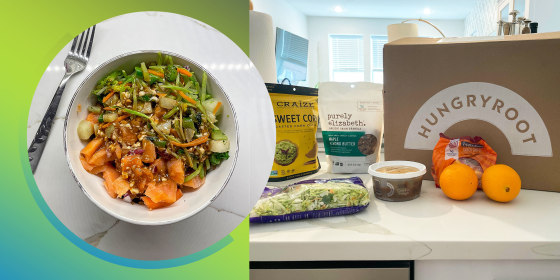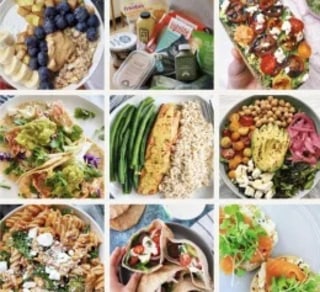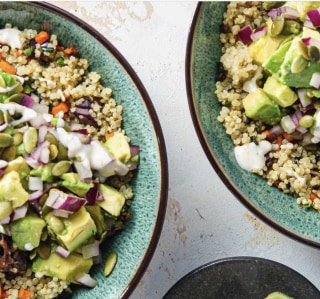For many, many years, my weeknight dinners consisted of a select few rotating proteins and whichever starches and vegetables would be the easiest to cook. (I ate a lot of rice.) Back then, I often found myself grabbing takeout at 9 p.m. after a busy day of commuting and evening workout classes. That 9 p.m. habit of mind wasn’t healthy for my body or my wallet, so I decided to give meal delivery services a try.
In 2020, I started to trial and error my way through the most popular meal kit delivery services: Home Chef, Freshly, Blue Apron, the list goes on. Each of these services had their benefits, but none of them were precisely what I was looking for — I am a pescatarian, and since my husband is an enthusiastic omnivore who can’t live without steak or grilled chicken, we tend to cook separately. I needed something that could cater to my diet and offer single portions, a rarity in the meal kit world.
Up until a few months ago, I was using CookUnity at the recommendation of a friend. It’s a pre-made meal delivery service, which means that all the meals came fully prepared — all I had to do was heat them in the microwave or oven. The meal offerings were extensive even with my dietary restrictions, but I grew tired of eating from takeout-like containers. I wanted something that felt fresh. So, when Hungryroot, a meal service plan that calls itself “the easiest way to eat healthy,” reached out to me and offered to send me a box from their unique meal delivery service to try out, I decided to give it a shot.
Hungryroot
Hungryroot, unlike the other meal kit services I had tried, combines a grocery delivery service and meal delivery service all in one. Here’s how it works: You sign up for a plan based on how many servings of each meal and snack you want, and those servings determine the number of credits you receive. For example, a plan with four servings of lunch and two servings of dinner costs $73 with shipping and gives you 28 credits. The lunch and dinner options give you a set of preselected ingredients with recipe instructions, but everything else — like snacks, sweets and pantry essentials — are à la carte. You have the option to go over your credit limit for an added fee, but Hungryroot otherwise automates preselected options that stay within your credit limit.
When Hungryroot sent me a box to try out, I didn’t choose what I received — instead, a rep for the company asked me for my dietary restrictions and food preferences and catered to both accordingly. (When you create a profile on the website, it similarly asks you for your dietary preferences and food likes/dislikes.) I scarfed down every single recipe and snack with delight, but what really sold me on the delivery service was the company’s Black Bean Brownie Batter, Cauliflower Linguine and Spinach Artichoke Sauce. (I’m getting hungry just writing this.)
I signed up for my own Hungryroot plan almost immediately after preparing the delicious soy chorizo tacos with butternut squash included in my complimentary box. My plan costs just under $100 a week: It includes four servings of lunch, two servings of dinner, 5-7 servings of snacks and 2-3 servings of sweets. There are certainly meal delivery services that are cheaper than Hungryroot — and for many people, those may be perfectly fine — but having tried several, I’m happy to pay a premium for healthier, high-quality ingredients that match my dietary needs.
To give you an idea of how varied the meals are, one of my weekly orders comprised a Blackened Shrimp Summer Salad, Garlicky Sole + Sauteed Spinach, a Poke Salmon + Asian Salad Grain Bowl, a bag of Purely Elizabeth Maple Almond Butter Granola, two Navel Oranges, a Roasted Red Pepper Hommus + Chips snack pack, a 6-pack of Cheddar Rounds and Sweet Corn Crackers. All of this lasted me the work week, supplemented by some eggs and yogurt for breakfast plus some frozen shrimp and rice for dinner. Hungryroot also encourages customization: You can let the algorithm know if you absolutely adore an item (like the Spinach Artichoke Sauce) or hate something (sorry, Mirepoix Mix). The algorithm will feature that item in your box accordingly.
Another perk of these premium ingredients and recipes? They take no time at all to prep and cook. I’ve tried more than a dozen recipes at this point, and the longest it’s taken me to prepare a meal from start to finish is about 30 minutes. I can’t afford to spend hours in the kitchen (nor do I want to), so I appreciate that Hungryroot doesn’t eat up too much of my time during the week. If I’m out of town, Hungryroot also makes it easy to pause my weekly delivery on the website.
Hungryroot’s meals aren’t always exactly what I’m looking for — I often “garnish” my salads and pastas with some feta cheese, and I like to add extra vegetables to my stir fries. However, every meal I’ve ever ordered has come with enough ingredients to put together a hearty dish, and I appreciate that I can still customize my meals a bit with my own personal touch (or feta supply).
Other meal delivery services to consider
If Hungryroot isn’t exactly what you’re looking for, here are some similar expert-recommended meal delivery services across various price points.
Sunbasket
Sunbasket offers several different menus to cater to specific diets, like vegetarian, gluten-free or pescatarian. Similar to Hungryroot, the service gives you the option to add snacks and grab-and-go dishes like egg bites to your order in addition to meal kits or prepared meals. “[It] has a variety of options that can be modified for carnivores and strictly plant-based eaters alike,” Lisa Moskovitz, a registered dietitian and CEO of NY Nutrition Group, previously noted in our guide to meal delivery kits.
Purple Carrot
Purple Carrot offers both meal kits and prepared meals that focus on plant-based foods. This is a good option for those who are fully vegan or vegetarian or who want to incorporate more plants into their diet, experts told us in our guide to meal delivery kits. I’ve tried Purple Carrot before and I enjoyed the meals offered — however, since I do eat fish and prefer a high-protein diet, I ultimately decided it wasn’t right for me.
Catch up on Select's in-depth coverage of personal finance, tech and tools, wellness and more, and follow us on Facebook, Instagram and Twitter to stay up to date.





